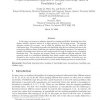Free Online Productivity Tools
i2Speak
i2Symbol
i2OCR
iTex2Img
iWeb2Print
iWeb2Shot
i2Type
iPdf2Split
iPdf2Merge
i2Bopomofo
i2Arabic
i2Style
i2Image
i2PDF
iLatex2Rtf
Sci2ools
AMAI
2006
Springer
2006
Springer
A split-combination approach to merging knowledge bases in possibilistic logic
In this paper, we propose an adaptive approach to merging possibilistic knowledge bases that deploys multiple operators instead of a single operator in the merging process. The merging approach consists of two steps: one is called the splitting step and the other is called the combination step. The splitting step splits each knowledge base into two subbases and then in the second step, different classes of subbases are combined using different operators. Our approach is applied to knowledge bases which are self-consistent and the result of merging is also a consistent knowledge base. Two operators are proposed based on two different splitting methods. Both operators result in a possibilistic knowledge base which contains more information than that obtained by the t-conorm (such as the maximum) based merging methods. In the flat case, one of the operators provides a good alternative to syntax-based merging operators in classical logic.
Related Content
| Added | 10 Dec 2010 |
| Updated | 10 Dec 2010 |
| Type | Journal |
| Year | 2006 |
| Where | AMAI |
| Authors | Guilin Qi, Weiru Liu, David H. Glass, David A. Bell |
Comments (0)

